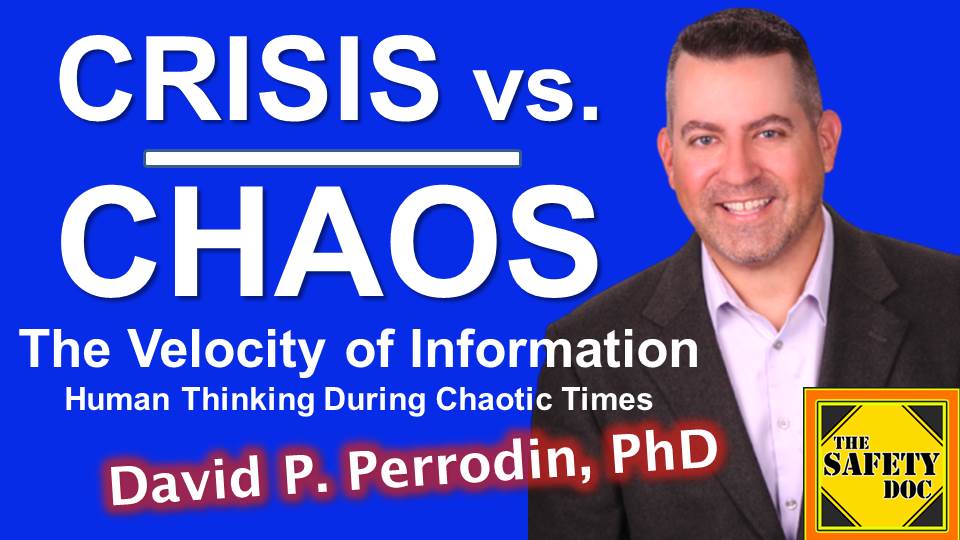Crisis vs. Chaos | Bifurcation and Strange Attractors | The Velocity of Information | SDP174
[Podcast] What are the differences between crisis and chaos? Is a sudden bifurcation better than a gradual bifurcation? How might a “strange attractor” contribute to the sometimes long duration, and difficult-to-recognize, patterns in chaos? Doc will discuss these questions and read an excerpt pertaining to them from his book ‘The Velocity of Information: Human Thinking During Chaotic Times.’

DIRECT LINK to MP3 of this Episode: https://tinyurl.com/SDP174-AUDIO
WHAT IS CRISIS? The following excerpts are from pages 139-140 of the book The Velocity of Information: Human Thinking During Chaotic Times. “Crisis implies a decisive point in a dangerous situation with anticipation of an abrupt change to the condition, for better or for worse. [A] crisis is often of short duration and will have an identifiable turning point(s). It tends to scale in a predictable manner. People believe their own actions might resolve a crisis. This is a key distinction between crisis and chaos. While people believe that they can negotiate to resolve a crisis, the mindset when faced with chaos is to survive, or “wait-out” the condition.
HARD OR SOFT BIFURCATIONS. A crisis may be characterized by a bifurcation, which is a parameter-dependent change in dynamical behavior. A useful distinction exists between hard (abrupt) and soft (gradual) bifurcations. Hard bifurcation: the ice on a lake slowly warms (temperature is the bifurcation parameter) and suddenly breaks, dropping you into the cold lake. Soft bifurcation: an ice cube (temperature is again the bifurcation parameter) once at a temperature greater than or equal to 32 degrees slowly melts into a glass of Scotch. A soft bifurcation is clearly preferable, particularly because its impacts are dispersed over time.
STRANGE ATTRACTORS (Has Nothing To Do With Gravity). As mathematically defined, a crisis occurs with the appearance of a strange attractor. The word “attractor” has nothing to do with gravitation. As in dynamic systems, attractors provide a way to describe the asymptotic behavior of typical orbits. Operationally, this means that there is a dramatic change in the dynamical behavior of the system. The present disconnects from the past and the past behavior has little or no predictive value as the system navigates its way through a profoundly altered landscape. An undetected, racing comet with a 20,000 year orbit could be a strange attractor that alters life on earth.
HYPERINFLATION AS A STRANGE ATTRACTOR. In a fiat money economy, sudden-onset hyperinflation might be characterized as a strange attractor resulting in extraordinary behaviors in the country’s monetary system. For example, during the 1923 hyperinflation crisis of the Weimar Republic, “workers were often paid twice per day because prices rose so fast their wages were virtually worthless by lunchtime (1).” In addition, “[f]armers refused to take any form of paper money for their crops. The harvest of 1923 sat in farmers’ warehouses while supermarkets in the cities were empty. Starvation and civil unrest loomed (2).”
WHAT IS CHAOS? “Chaos is a state of disorder that is amorphous and without clear turning points. Chaos quickly or gradually settles into outcome basins or creates a new mean. Chaos describes a system that will develop in unpredictable ways and will not scale linearly. It exists on a continuum with degrees of absorption by systems. A state of chaos, due to a lack of, or impossibility of, a scripted response will usually, if not inevitably, spread. Chaos affects the global consciousness, even if only temporarily. The 2011 Tohoku earthquake and tsunami near Japan was a chaos event that killed 15,899 people and caused the Fukushima nuclear energy plant disaster.
CITATIONS: (1) BBC. “Bitesize The Weimar Republic 1918-1929: The Hyperinflation Crisis, 1923.” https://www .bbc .co .uk /bitesize /guides /z9y64j6 /revision /5.; (2) Forbes. “In Hyperinflation’s Aftermath, How Germany Went Back to Gold.” Forbes .co m. June 9, 2011. https://www .forbes .com /2011 /06 /09 /germany -gold -standard.html ?sh =330426c35934.
This is episode 174 of The Safety Doc Podcast published on 03-22-2022. This podcast and blog post represent the opinions of David P. Perrodin and his guests to the show. The content here is for informational purposes only. Please consult with your safety professional regarding the unique needs of yourself or your organization.
FOLLOW
- Watch this episode on “The Safety Doc” YouTube channel https://tinyurl.com/SDP174-VIDEO
- Listen to this episode on PodBean MP3 https://tinyurl.com/SDP174-AUDIO
- Apple Podcasts http://tinyurl.com/SafetyDocApplePodcasts
- SAFETY DOC WEBSITE & BLOG safetyphd.com
- Follow David & The Safety Doc Podcast on Twitter @SafetyPhD
- Email Dr. Perrodin [email protected]
Purchase Dr. Perrodin’s books
School of Errors – Rethinking School Safety in America
The Velocity of Information – Human Thinking During Chaotic Times
